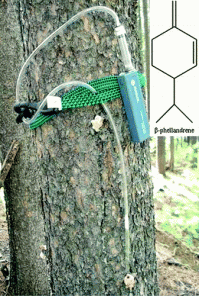Beetle-infested pine trees contribute more to air pollution and haze in forests

The hordes of bark beetles that have bored their way through more than 6 billion trees in the western U.S. and British Columbia since the 1990s do more than damage and kill stately pine, spruce and other trees. A new study finds that these pests can make trees release up to 20 times more of the organic substances that foster haze and air pollution in forested areas. It appears in ACS' journal Environmental Science & Technology.
Kara Huff Hartz, Gannet Hallar and colleagues explain that western North America is experiencing a population explosion of mountain pine beetles, a type of bark beetle that damages and kills pines and other trees. The beetles bore into the bark of pine trees to lay eggs. Gases, called volatile organic compounds (VOCs), which act as defense mechanisms against the beetles, are released from the bore holes. VOCs, however, also contribute to the smog and haze that obscures views of natural landscapes in U.S. National Parks and other nature areas where tourists gather in the summertime. To determine exactly how beetle attacks affect the atmosphere, the researchers measured VOC levels in the air near healthy and infected pine trees.
They found that beetle-infested trees release up to 20 times more VOCs than healthy trees near the ground surface. The predominant type of VOC was a monoterpene called ß-phellandrene. The data suggest that the bark beetle epidemic in the western U.S. could have led to higher monoterpene concentrations in the air that can contribute to haze, which can harm human health, reduce visibility and impact climate, say the researchers.
More information: Effect of Bark Beetle Infestation on Secondary Organic Aerosol Precursor Emissions, Environ. Sci. Technol., Article ASAP. DOI: 10.1021/es204205m
Abstract
Bark beetles are a potentially destructive force in forest ecosystems; however, it is not known how insect attacks affect the atmosphere. The emissions of volatile organic compounds (VOCs) were sampled i.) from bark beetle infested and healthy lodgepole pine (Pinus contorta var. latifolia) trees and ii.) from sites with and without active mountain pine beetle infestation. The emissions from the trunk and the canopy were collected via sorbent traps. After collection, the sorbent traps were extracted with hexane, and the extracts were separated and detected using gas chromatography/mass spectroscopy. Canister samples were also collected and analyzed by a multicolumn gas chromatographic system. The samples from bark beetle infested lodgepole pine trees suggest a 5- to 20-fold enhancement in total VOCs emissions. Furthermore, increases in the β-phellandrene emissions correlated with bark beetle infestation. A shift in the type and the quantity of VOC emissions can be used to identify bark beetle infestation but, more importantly, can lead to increases in secondary organic aerosol from these forests as potent SOA precursors are produced.
Journal information: Environmental Science & Technology
Provided by American Chemical Society














